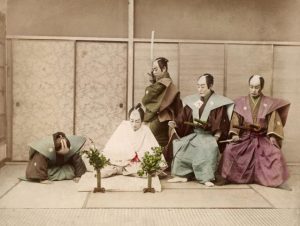
A staged version of the Japanese ritual suicide known as Seppuku or Hara-Kiri, circa 1885. The warrior in white plunges a knife into his belly, while his second stands behind him, ready to perform the decapitation. (Photo by Sean Sexton/Getty Images)
As an anime fan, one thing that I have grown to love and appreciate is the diversity and uniqueness of both modern and traditional Japanese culture. One practice that does stand out to me is the practice of the honorable death known as Seppuku. Seppuku, death by self-disembowelment, became a ritualized and institutionalized form of suicide among the Samurai in Feudal Japan; and it was seen has a form of honor and courage reserved for the Samurai, the traditional Japanese military. I was interested in learning a little bit more about this practice especially with our recent class discussions of what constitutes a “good” death or a “bad” death.
The deaths of Minamoto Yorimasa, a poet, and Minamoto Tametono, a samurai, describes the earliest known acts of Seppuku. Seppuku, which describes a process of slicing the stomach open, was considered the most courageous, straightforward and bravest way to die because the stomach was considered to be where the human spirit resided. In these practices, witnesses would sit discreetly to the side while the samurai, dressed in white, would kneel on large white cushion. The Samurai would then inflict the fatal injury to his stomach and his Kaishakuin, second in command or assistant, would make sure the Samurai did not experience prolonged suffering and ensured a honorable death.
Seppuku’s adoration and inspiration in Japanese culture has remained even today and can be seen depicted in movies, plays, novels, anime and more. During WWII, in the Pacific Islands, American soldiers witness Japanese militia committing this ritual right before their very eyes. After losing the war, some men and women performed the ritual in order to serve as an apology to the Emperor of Japan. But for people who are not Japanese the practice has been held with horrid fascination.I think this is because each individual has their own qualms about the topic of death and even more so suicide. So for me, it is interesting to see how understanding death is highly influenced by the culture, the society and the time and how they all play a major role in determining what constitutes a “good” or “bad” death.
References
Fusé, Toyomasa. “Suicide and culture in Japan: A study of seppuku as an institutionalized form of suicide.” Social Psychiatry 15.2 (1980): 57-63.
